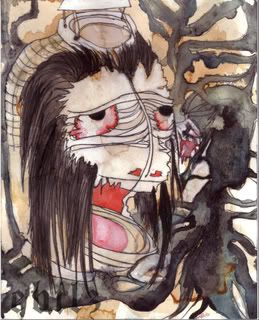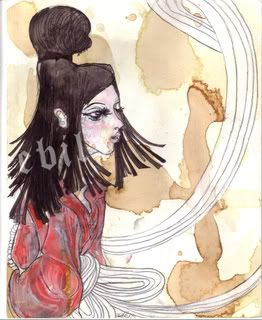The Ghost of Oiwa
Oiwa is an onryō, a ghost who seeks vengeance. Her strong passion for revenge allows her to bridge the gap back to Earth. She shares most of the common traits of this style of Japanese ghost, including the white dress representing the burial kimono she would have worn, the long, ragged hair and white/indigo face that marks a ghost in kabuki theater. There are specific traits to Oiwa that set her apart physically from other onryo.
Most famous is her right eye, which droops down her face due to poison given her by Iemon. This feature is exaggerated in kabuki performances to give Oiwa a distinct appearance.
She is often shown as partially bald, another effect of the poison.
Yotsuya Kaidan (四谷怪談), the story of Oiwa and Iemon,[1] is a tale of betrayal, murder and ghostly revenge. Arguably the most famous Japanese ghost story of all time, it has been adapted for film over 30 times, and continues to be an influence on Japanese horror today.
Written in 1825 by Tsuruya Nanboku IV as a kabuki play, the original title was Tōkaidō Yotsuya Kaidan (東海道四谷怪談). It is now generally shortened, and loosely translates as Ghost Story of Yotsuya.[2]
Oiwa and Iemon
The story opens with a murder. Iemon, an unemployed ronin married to Oiwa, killed his father-in-law because he was aware of Iemon's evil past deeds. Penniless, Iemon has been forced to make his living as an oilpaper umbrella maker in order to support his delicate wife and new child. This situation has led him to resent Oiwa.
Iemon is lured into a scheme to marry the beautiful granddaughter of a well-to-do neighbor, who is in love with him. In order to clear the path for the new marriage, Iemon and the neighbor plot to murder Oiwa. Iemon gives Oiwa poison disguised as "blood-road medicine," intended to bring back her strength. The poison does not kill her, but instead disfigures her, causing her hair to fall out and her eye to droop. When a mirror is held in front of her, her despair at her disfigurement and the knowledge of her husband's betrayal causes her to die.
When a faithful servant, Kobote Kohei, becomes aware of the murder, Iemon accuses him of theft and has him killed. He then has Kohei and Oiwa's bodies crucified on two sides of a wooden door, which is then flung into a nearby river.
Thinking his troubles are over, Iemon plans his new marriage. On his wedding day to his new bride, Iemon lifts her veil to see Oiwa's ruined face. He instantly beheads her, only to discover he has killed his new bride. Horrified, he flees to the neighbor's house to confess, where he is confronted by Kohei's ghost. Slashing at the ghost, Iemon finds he has killed his neighbor, his new father-in-law.
From there the haunting continues, with the vengeful spirit of Oiwa pursuing Iemon. Everywhere he goes, he sees her ruined face, even projecting from an overhead lantern. Seeking escape, he retreats to the mountains and goes fishing. Instead of fish, he hooks the board with the corpses of Oiwa and Kohei. He then flees to a cabin in Hebiyama, where the ropes and vines of the cabin transform into snakes and the smoke from the fire transform into Oiwa's hair.
Fleeing the cabin, he runs into his brother-in-law, who kills Iemon and avenges all of the murders.
buy here :)
:: ebilz on the interwebz ::
4.9.08
3.9.08
the spider princess
The spider Princess
In 976, Minamoto no Raiko was tormented at night by a monstrous spider, so his retainer, Sakata Kintoki, lodged in the chambers to capture it. The story is told in the play Tsuchigumo.
She doesn't look much like a monster, does she? Sakata has been dozing with his head on a go board. Hearing her noise, He peeks awake as a seductive woman, apparently an apparition created by the spider, glides by (you can tell she is a ghostly thing --). She looks more intent on mischief than mayhem, if you ask me....
prints will be available in my online shop later this week.
Subscribe to:
Posts (Atom)


